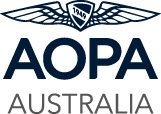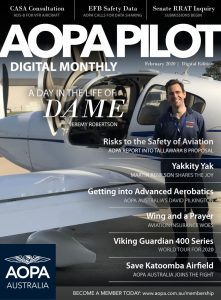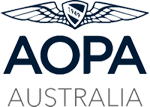To no surprise, Nicholas Christie’s editorial of July 9th, titled; “Increased MTOW and Access to CTA for RAAus: When?”, has sparked considerable social media debate with a broad cross section of opinions and arguments being put forward.
I firmly believe that public discussion and debate is both healthy and invaluable for our industry and it is important that we openly discuss the issues facing our community, whilst seeking to understand all sides of the debate so that effective solutions can be found. I encourage more of our members to become involved by providing their comment but remind everyone of the need to keep our responses respectful at all times.
Like many aviators throughout the industry, AOPA Australia is eager to see the Public Consultation for the Part 149 Self-Administration Recreational Aviation Australia (Part 149 RA-Aus) application for an MTOW increase to 760kgs put on the table for comment – and for good reason.
AOPA Australia’s view is that ‘recreational’ flying encompasses all pilots across the general aviation industry who seek to ‘fly for fun’, regardless of which license they hold (RPC, RPL or PPL) or which association they’re a member of. The word ‘recreational’ is not owned by any one organisation and should not be used to drive division within the industry. There is no us versus them and we all have a right to persue and enjoy the benefits of aviation equally.
AOPA Australia believes that CASA should bring forward it’s public consultation on the Part 149 RA-Aus application for a higher MTOW – the sooner the better. This could be the perfect opportunity for CASA to abolish its unnecessary pilot medical dual-standards, implementing an industry wide self-certification standard for all RPC, RPL and PPL holders who elect to fly recreationally.
Under current regulation, CASA have approved pilots who fly under the Part 149 RA-Aus, the use of a self-certification medical standard, permitting them to fly outside of controlled airspace with one passenger on board, flying an aircraft with an MTOW of up to 650kgs.
Without question, CASA’s approval constitutes a safety endorsement and clearly communicates that a self-certification standard is safe for use by pilots outside of controlled airspace with one passenger onboard.
Yet despite this fact, CASA have denied government regulated RPL and PPL holders who seek to fly recreationally (i.e. outside of controlled airspace with just one passenger) the same medical standard. This refusal is contrast against the fact that RPL and PPL holders are trained to a higher level of pilot capability and that they operate aircraft that are built and maintained to a much higher standard than their Part 149 RA-Aus RPC counterparts.
CASA’s position defies logic and common sense – it’s plain wrong.
Lets consider CASA’s current thinking from a viewpoint of newly licensed pilots… CASA have declared that its safer for less experienced pilots within the Part 149 RA-Aus flying aircraft built to the industry’s lowest standards to fly on a self-certification medical carrying a passenger. Whilst at the same time arguing that pilots trained to CASA’s highest private standards (PPL), in aircraft that are built and maintained to the industry’s highest certification requirements (FAR23), cannot safely operate outside of controlled airspace with a passenger onboard, flying with a self-certification medical!
It’s outright crazy and if industry’s frustrations with CASA’s woefully floored logic weren’t bad enough, even the Senate Regional Rural Affairs Transport Committee (RRAT) couldn’t get a straight answer as to why.
CASA’s only response has been it’s demand that pilots seeking to fly recreationally on a self-certification medical standard become paying customers of the Part 149 RA-Aus to gain access. Simply pay a fee to a private company and it instantly becomes safe to fly on a self-certification medical standard – so CASA says.
Let’s be clear, CASA’s refusal to provide a self-certification medical for RPL and PPL holders has nothing to do with maintaining aviation safety – period. Rather, it is a blatant and wholesale abuse of CASA’s regulatory powers, conceived to connive with the Part 149 RA-Aus whom financially benefit from the discriminatory dual-standard being enforced.
This is the kind of behavior found in third world countries.
Soon our industry will be asked for public comment on whether CASA should permit heavier aircraft to be flown by Part 149 RA-Aus RPC holders using self-certification medicals. Allowing the very aircraft that CASA says are not safe to be flown by government regulated RPL and PPL holders who are trained to a higher standard!
If CASA approves an MTOW increase for the Part 149 RA-Aus, without simultaneously delivering an industry wide self-certification medical standard for all RPC, RPL and PPL holders seeking to fly recreationally, then it is clearly communicating that its safety functions have become corrupted by corporate self-interests.
To be clear, AOPA Australia is on the public record as being supportive of a 760kg MTOW increase for the Part 149 RA-Aus – on the basis that CASA delivers an industry-wide self-certification medical standard for all pilots – RPC, RPL and PPL.
A pilot’s right to a medical should not be used as an economic bargaining tool for any Part 149 to garner an unfair advantage, nor should CASA be using it’s regulatory powers to provide such.
Furthermore, AOPA Australia entirely rejects CASA’s assertion that aircraft weight defines aviation safety in the recreational sector. It simply is not true – and CASA knows this.
Pilot safety is a direct outcome of the quality and standard of training that pilots receive, underpinned by the standard of flight training instruction that is made available to industry and the level of pilot support and operational oversight that is enforced.
In simplicity, there are only three relevant questions to recreational aviation safety;
- Is the pilot appropriately trained?
- Is the aircraft maintained properly, equipped for purpose and airworthy?
- Is the pilot fit to fly?
The aviation safety argument for recreational flying does not start with aircraft weight or pilot medicals, but instead; is the pilot appropriately trained for the operations they intend to conduct?
If a pilot lacks the appropriate standard of training and competency in the relevant airspace and aircraft they are seeking to operate, then regardless of the aircraft’s weight or which medical the pilot holds, they shouldn’t be flying – it’s a simple and obvious argument.
It’s time that the issue of pilot medicals was dealt with transparently and with complete honesty.
It’s now time for CASA to show Australia that it is a legitimate safety regulator for the whole of industry and that pilot rights are not being manipulated by the forces of corporate self-interest and that CASA’s safety functions have integrity, by delivering a self-certification medical standard for all pilots who choose to fly recreationally.
Importantly, when the public consultation is announced, I invite and encourage all pilots every last industry participant to make a formal submission to CASA that communicates our industry’s collective desire to see all pilots treated equally regardless of which association we belong to – RPC, RPL and PPL we are all pilots.
[adrotate banner=”3″]






